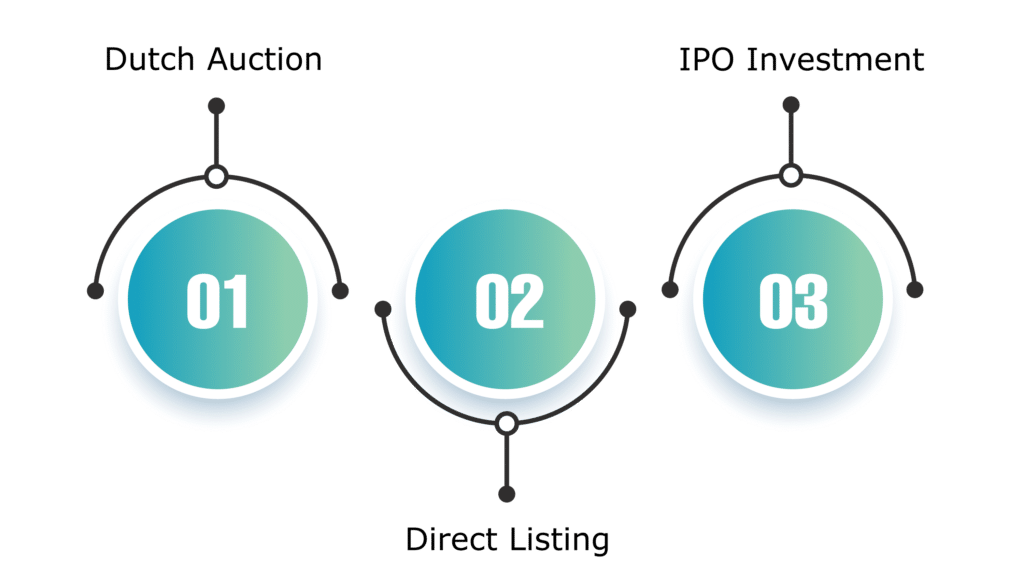
What is an Initial Public Offering (IPO)?
An Initial Public Offering (IPO) is the process through which a private company offers its shares to the public for the first time by listing them on a stock exchange. This event marks a significant milestone in a company’s lifecycle, transforming it from a privately-held entity into a publicly-traded firm.
Going public via an IPO allows the company to raise capital from public investors, which can be used for expansion, debt repayment, research and development, or other strategic goals.
For early investors and founders, an IPO also acts as a liquidity event—a moment to realize the gains on their investments as their private equity can now be traded in public markets, often at a premium valuation.
Key Points to Note About IPOs
Now that you have a basic understanding of what an IPO is, let’s look at some important aspects:
- Regulatory Compliance: To conduct an IPO, companies must meet the requirements set by the U.S. Securities and Exchange Commission (SEC) or the equivalent securities authority in their country. This includes submitting a detailed registration statement (typically the S-1 form in the U.S.) disclosing financials, risks, and business plans.
- Raising Capital: IPOs provide companies with access to capital by selling shares in the primary market. This influx of funds can be crucial for growth and long-term sustainability.
- Role of Investment Banks: Companies usually appoint investment banks (also known as underwriters) to guide them through the IPO process. These banks help determine the IPO price, timing, demand, and investor outreach through roadshows.
- Exit Strategy for Early Investors: For initial investors, founders, and venture capitalists, an IPO is often seen as a structured exit strategy. It allows them to sell part or all of their holdings and realize returns on their early investments.
How Does An Initial Public Offering Work?
A firm is said to be private before filing an initial public offering. Before a firm issues an initial public offering it operates with a small group of stakeholders such as new funders like family, the owners, and pals. The group of stakeholders also includes angel investors or venture capitalists who come under the category of professional investors.
Issuing an initial public offering is like hitting a major goal for the firm as it offers the business the access to raise huge capital. Apart from a good raise in revenue, an initial public offering also helps the firm is expanding and growing its business. Better transparency and authority of share listing is another reason why an initial public offering helps in getting good terms when finding borrowed funds.
Once a firm attains a position during its phase of growth where it is sure of being worthy enough to face the demands of the SEC and to match the responsibilities of public stakeholders, it should begin promoting its news of going public. Generally, companies will reach this phase of growth after hitting the private valuation of at least $1 billion. This phase is commonly known as the unicorn stage.
Many firms which have powerful roots, a good profit potential, and an impressive valuation can apply for an initial public offering. A firm should apply for an initial public offering after properly studying the competition in the market, and its capability to match the listing needs. Any firm sets up the cost of its IPO shares with whole diligence. So, when a firm converts into a public company, the previously possessed private share firm becomes public ownership, and this way the shares of the private stakeholders become worthy of the public trading cost.
Usually, this conversion period is very crucial for firms to make and bring in the expected returns. The private stakeholders can either sell some portion or all of their shares for profit, or they can choose to keep them as it is in the public market.
Nevertheless, the funders can get shares in a firm and make a good capital contribution to a firm’s stakeholder equity with the help of a public market. It is safe to say that it opens gates for billions of funders. The public comprises any institutional or individual funder who takes a keen interest in providing funds to the company.
A firm’s new stakeholder’s equity status gets decided based on the number of shares that a firm sells, and also on the cost at which they get sold. A stakeholder’s equity signifies the shares investors possess when the firm is both, public and private. But, when a firm issues an initial public offering, with the help of money from the initial filing, the equity of the stakeholders increases exclusively.
The IPO Process
An Initial Public Offering (IPO) typically unfolds in two major phases:
- Pre-Marketing Phase
- Public Offering Phase
A company begins showing interest in going public when it engages underwriters, often through private proposals or public announcements, to gauge investor interest. Once selected, underwriters play a central role in steering the entire IPO process—from regulatory filings to final pricing.
Step-by-Step Breakdown of the IPO Process
1. Underwriter Proposals
Investment banks (underwriters) pitch proposals to the company, offering services related to:
- Estimated company valuation
- Type of security to be issued
- Number of shares to be offered
- Indicative price range
- Expected IPO timeline
2. Underwriter Selection
The company selects one or more underwriters and signs an official underwriting agreement that defines their role and responsibilities.
3. IPO Team Formation
An IPO team is assembled, which typically includes:
- Underwriters
- Legal advisors
- Certified Public Accountants (CPAs)
- SEC filing experts and consultants
4. Regulatory Filings (S-1 Registration Statement)
The company prepares and files Form S-1 with the Securities and Exchange Commission (SEC). This document includes:
- The Prospectus: Publicly available document with business details, financials, and risk factors.
- Confidential Information: Additional internal documentation for SEC review.
This document is revised multiple times throughout the review process.
5. Marketing & Roadshows
Marketing materials are developed to generate investor interest. This phase is known as the “roadshow”, where company executives and underwriters:
- Meet with institutional investors
- Gauge demand
- Finalize the offer price and issue size
Based on investor feedback, the IPO price and issue date may be adjusted. Regulatory compliance with SEC and stock exchange listing requirements is strictly maintained.
6. Corporate Governance Readiness
The company must:
- Appoint a Board of Directors
- Establish internal controls for financial reporting and auditing
- Implement compliance frameworks required of a public company
7. Share Issuance
On the IPO day:
- Shares are officially listed on a stock exchange (e.g., NASDAQ or NYSE)
- Capital is raised from the sale of shares to public investors
- The funds are recorded as shareholder’s equity in the company’s financial statements
8. Post-IPO Phase
After going public:
- A lock-up period (usually 90–180 days) restricts insiders from selling shares
- Underwriters may exercise the greenshoe option to purchase additional shares (if demand is high)
- The company transitions into life as a publicly traded entity, with ongoing regulatory reporting, investor relations, and quarterly earnings releases
Advantages And Drawbacks of IPO
The main goal of a public offering is to gather money for a firm. But several other advantages and drawbacks come with it. Let’s learn more about it through the table given below:
| Advantages | Drawbacks |
|---|---|
| ● For firms
– Gathering funds – Credibility and publicity Reducing the company debt |
● For firms – Probability to lose control over the firm. – Disclosure of financial and confidential data of the firm. – Costs of audits are high |
| ● For funders
– Just and clear pricing – Minimal investment and good returns |
● For funders
– Detailed research is needed. – Private data is compromised. |
Talking about the main benefit of an IPO, it lets a firm have access to funding through the whole investing public for raising capital. This leads to quicker share conversions, raises the firm’s exposure, public image, and prestige. This in return helps the firm is raising its profits and sales. Good transparency can be attained with necessary frequent reporting. This lets the firm get a good credit borrowing position than a private firm.
Now, coming to the drawbacks. After going public, firms may have to go through some downsides. Some of them are that getting an IPO is expensive, the cost of managing a public firm is usually high when compared to the maintenance price of other businesses.
Alternatives of IPO

There are certain alternatives to IPO, let’s have a look at them:
1. Dutch Auction
In this type of offering, no IPO is set. The potential investors can simply bid for the desired shares, and the cost they wish to pay. The buyers who agree to give the greatest price are then offered the available shares.
2. Direct Listing
This kind of alternative is used when underwriters are not appointed, and an IPO is held without them. Direct listings don’t require the underwriting procedure. This also put the issuer at risk if the IPO doesn’t give good results. But the issuer is also bound to benefit from a greater share cost. This type of listing is best for a firm that has a high-end brand value, and an exciting business.
3. IPO Investment
Only after giving it a thorough consideration, and doing a proper evaluation, does a firm decide to make money through an IPO. When a firm takes this decision, it ensures that after this step the returns of new investors will expand and gain maximum capital for their business. That’s why when the IPO judgment is finalized, the chances of business growth are usually predicted to be great. Hence several investors try to fit in and lay their hands first on the shares. Generally, IPOs are fixed at discounted rates to enhance sales, make them seem more attractive, and gather maximum investors from the first issuance.
Primarily, the cost of an IPO is generally fixed by the appointed underwriters via the pre-marketing procedure. At the fundamental level, the IPO cost is dependent on the firm’s valuation by basic techniques. The general technique that’s used is discounted cash flow. It represents the net current value of the firm’s prospected cash flows.
This value is taken on a per-share foundation by the interested buyers and underwriters. Other techniques to fix the cost of an IPO are enterprise value, comparable firm adjustments, equity value, etc. The underwriters keep all the factors in mind before fixing the rates of an IPO and also ensure that the prices are discounted to get a good outcome on the day of the IPO launch.
Execution of an IPO
Multiple criteria may adversely modify the return rate of an IPO. Such factors are keenly studied by the buyers. There are some IPOs that might be over-promoted by the investment banks and can later lead to primary losses.
Nevertheless, a major chunk of IPOs is popular for gathering good results in short-term exchange once they get out in the public. Still, there are some important factors to look out for in the execution of an IPO:
Flipping
This term indicates the process of re-selling an initial public offering stock in its early days to get an easy profit. Such a condition is common for the stocks sold at discounted rates and rises on its day 1 of trading.
Lock-Up Contract
Once a firm decides to convert to the public, the hired underwriters ensure firm insiders like the officials and workers, submit a lock-up statement. These agreements are officially binding deals signed between the firm insiders and the underwriters, limiting them from giving out company shares for a certain time. This period can lie between 3-24 months.
Waiting Periods
Certain investment banks incorporate waiting periods into their IPO provisions. This preserves some shares from getting sold after a certain period. Their cost might rise if this provision is accepted by the appointed underwriters, and it may dip if not.
Read More: Equity Funds
Conclusion
All in all, IPO holds a lot of power, and applying for it is a very important switch in the life of a private company. The interested buyers can follow the information given in this article, gather information, stay updated with the headlines, and then invest their best. We hope that this article helped you in understanding everything from the basics to the deep details about an initial public offering (IPO).
FAQ’s
Because the demand for an IPO surpasses its supply, there’s no definite guarantee that all interested buyers can get the shares.
IPOs are known to render good gains and a great return rate for a firm. Being said that there is always a risk of loss. That’s why buyers should carefully judge every IPO.

